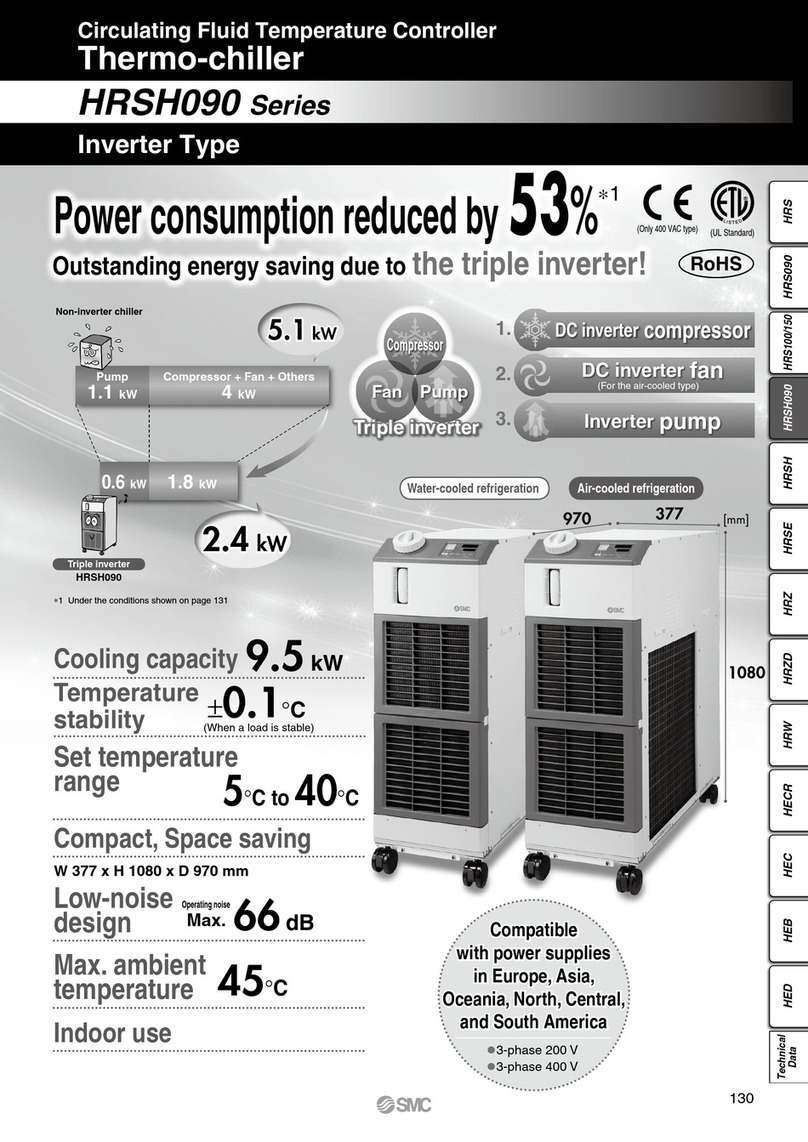
(UL Standards)
How to Order
Option 1
Nil None
AWith caster adjuster-foot
DElectric conductivity control
K∗1With fluid fill port
M
Applicable to deionized water piping
∗1 This is a manual fluid fill port that is
different from the automatic fluid fill
port. Fluid can be supplied manually
into the tank without removing the
side panel. (Fluid can be supplied
manually for models without option K
if the side panel is removed.)
Power supply
46
3-phase 380 to 415 VAC (50/60 Hz)
3-phase 460 to 480 VAC (60 Hz)
Pipe thread type
Nil
Rc
F
G (With Rc-G conversion fitting)
N
NPT (With Rc-NPT conversion fitting)
Cooling method
A
Air-cooled refrigeration
Cooling capacity
400
38 kW
HRS 400 A
46
Thermo-chiller
Air-cooled 460 V Type
Standard Type
HRS400 Series
Specifications
Model HRS400-A-46
Cooling method Air-cooled refrigeration
Refrigerant R410A (HFC)
Refrigerant charge kg 3.7
Control method PID control
Ambient temperature/Altitude
∗1, 7, 9 °CTemperature: –5 to 45, Altitude: less than 3000 m
Circulating fluid system
Circulating fluid∗1, 2
Tap water, 15% Ethylene glycol aqueous solution, Deionized water
Set temperature range∗1°C5 to 35
Cooling capacity∗3, 7 kW 38
Heating capacity∗4kW 8
Temperature stability∗5°C±0.1
Pump
capacity
50/60 Hz
Rated flow (Outlet) L/min 125 (0.45 MPa)
Maximum flow rate L/min 180
Maximum pump head m68
Minimum operating flow rate∗6L/min 40
Tank capacity L 60
Circulating fluid outlet, circulating fluid return port
Rc1 (Symbol F: G1, Symbol N: NPTG1)
Tank drain port Rc3/4 (Symbol F: G3/4, Symbol N: NPTG3/4)
Automatic
fluid fill
system
(Standard)
Supply side pressure range
MPa 0.2 to 0.5
Supply side fluid temperature
°C5 to 35
Automatic fluid fill port Rc1/2 (Symbol F: G1/2, Symbol N: NPTG1/2)
Overflow port
Rc1 (Symbol F: G1, Symbol N: NPTG1)
Fluid contact material Metal
Stainless steel, Copper (Heat exchanger brazing), Brass, Bronze
Resin PTFE, PU, FKM, EPDM, PVC, NBR, POM, PE, NR, PBT
Electrical system
Power supply
3-phase 380 to 415 VAC (50/60 Hz)
Allowable voltage range ±10% (No continuous voltage fluctuation)
3-phase 460 to 480 VAC (60 Hz)
Allowable voltage range ±4%, –10% (Max. voltage less than
500 V and no continuous voltage fluctuation)
Applicable earth leakage
breaker (Standard)
Rated current
A40
Sensitivity of leak current
mA 30
Rated operating current∗5A22
Rated power consumption∗5
kW(kVA)
14.3 (15.2)
Noise level (Front 1 m/Height 1 m)∗5
dB(A) 71
Waterproof specification IPX4
Accessories
Operation Manual (for installation/operation) 1 pc. (English),
Y-strainer (40 meshes) 25A, Barrel nipple 25A,
Anchor bolt fixing brackets 2 pcs. (including 6 M8 bolts)
Weight (dry state) kg Approx. 340
∗1 When the ambient temperature or circulating fluid
temperature is 10°C or below, refer to "Operation at
low ambient temperature or low circulating fluid tem-
perature" (page 15).
∗2 Use fluid in condition below as the circulating fluid.
Tap water: Standard of The Japan Refrigeration And
Air Conditioning Industry Association (JRA GL-02-
1994)
15% ethylene glycol aqueous solution: Diluted with
clean water, without any additives such as antisep-
tics.
Deionized water: Electric conductivity 1 μS/cm or
higher (Electric resistivity 1 MΩ·cm or lower)
∗3 qAmbient temperature: 32°C, wCirculating fluid:
Tap water, eCirculating fluid temperature: 20°C, r
Circulating fluid flow rate: Rated flow, tPower sup-
ply: 400 VAC
∗4 qAmbient temperature: 32°C, wCirculating fluid:
Tap water, eCirculating fluid flow rate: Rated flow,
rPower supply: 400 VAC
∗5 qAmbient temperature: 32°C, wCirculating fluid:
Tap water, eCirculating fluid temperature: 20°C, r
Load: Same as the cooling capacity, tCirculating
fluid flow rate: Rated flow, yPower supply: 400 VAC,
uPiping length: Shortest
∗6 Fluid flow rate to maintain the cooling capacity. If the
actual flow rate is lower than this, install a bypass
piping.
∗7 If the product is used at an altitude of 1000 m or
higher, refer to “Operating Environment/Storage Envi-
ronment” (page 14) Item 13 “For altitudes of 1000 m
or higher.”
∗8 The anchor bolt fixing brackets (including 6 M8 bolts)
are used for fixing to wooden skids when packaging
the thermo-chiller. No anchor bolt is included.
∗9 For the product operation in the UL compliant condi-
tions, refer to “Operating Environment/Storage Envi-
ronment” (page 14).
1





























